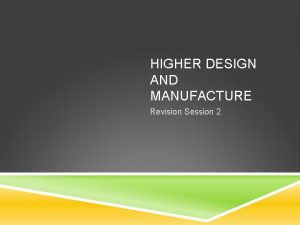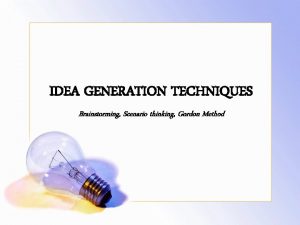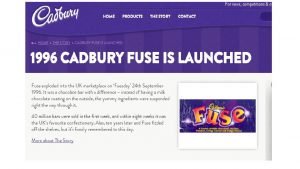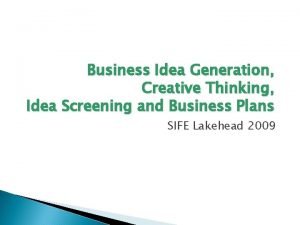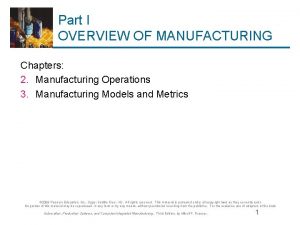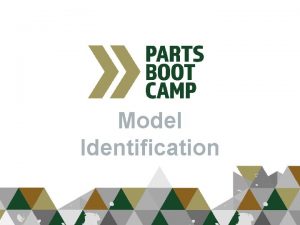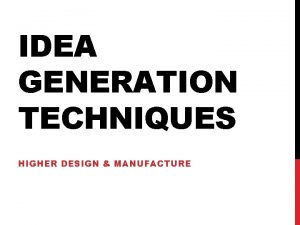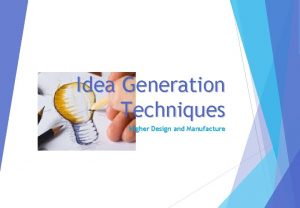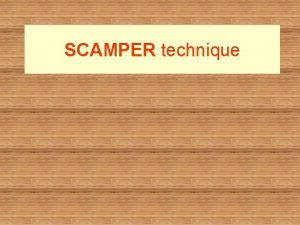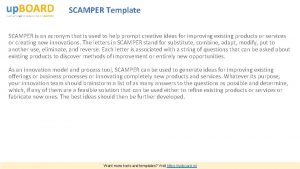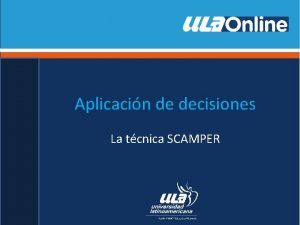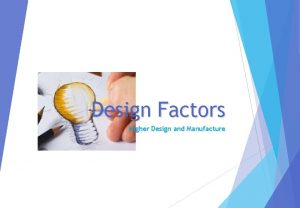IDEA GENERATION TECHNIQUES HIGHER DESIGN MANUFACTURE SCAMPER S











- Slides: 11

IDEA GENERATION TECHNIQUES HIGHER DESIGN & MANUFACTURE

SCAMPER S • Substitute • Think about replacing part of the problem with something else. C • Combine • Think about combining two or more parts of your ideas to produce new concepts. A • Adapting an exciting idea can identify a solution to your problem. M • Magnify/Minify • Enlarging or reducing the idea may offer more insight into what components are key P • Put to other use • Can your idea be put to another use or applied differently E • Eliminate • Reduce or eliminate components to refine idea to what is important R • Rearrange (or reverse) • Can the idea work in a different order? Could it be inverted to work differently?

ANALOGY An analogy is a comparison of two different product in order to highlight some point of similarity. It is basically similar technology applied to do different things. An example would be a pair of pliers and a nutcracker. All that is different is the position of the pivot.

BIO MIMICRY This is where examples from nature applied to a design to create new products or improve existing products. Examples of this in action are below.

MORPHOLOGICAL ANALYSIS This technique allows you to find new combinations of products. A table should be constructed where the column/row headings are attributes of the product. You then list as many different variations of that attribute as possible. A pathway should be created through the table to create the basis for a new product

BRAINSTORMING It typically includes such techniques as free writing, free speaking, word association, and drawing a mind map, which is a visual note taking technique in which people diagram their thoughts. A word of warning, avoid using brainstorming as a technique to develop your ideas.

THOUGHT SHOWERS Thought showers are carried out in groups and are effective in developing large numbers of ideas to the solution. Essentially, other people may see solutions where the designer has not. A few simple rules should be followed: ~ No criticism of any ideas is allowed – judgement is withheld until later ~ All ideas are welcomed, no matter how bizarre they may seem ~ Emphasise should be placed on generating a large number of ideas, building on someone else's idea to create a group chain is encouraged

TECHNOLOGY TRANSFERS Technology Transfer is the process of transferring skills, knowledge, technologies, methods of manufacturing, samples of manufacturing and facilities among governments or universities and other institutions. This ensures that scientific and technological developments are accessible to a wider range of users who can then further develop and exploit the technology into new products, processes, applications, materials or services. It is closely related to (and may arguably be considered a subset of) knowledge transfer.

LATERAL THINKING Lateral thinking is a way of approaching a problem from a different angle – a less conventional way. Some principles of lateral thinking • • Dominant ideas Looking at things differently Escaping from vertical logic Using chance

ASSESSMENT STANDARD 2. 3 Generating a range of ideas. WHAT YOU SHOULD DO Used a variety of techniques to generate ideas, seek alternatives and encourage a diverse approach to developing solutions Used linear and divergent approaches when developing design proposals

GENERATING YOUR IDEAS We have covered the main idea generation techniques, you should now select two techniques to generate your ideas. Some are more suited to this task than others however. Morphological Analysis SUITABLE TECHNIQUES Scamper Analogy Two different techniques should be adopted.
 Higher design and manufacture
Higher design and manufacture Stahl
Stahl You are good and your mercy endureth forever
You are good and your mercy endureth forever Product planning and development
Product planning and development Gordon method
Gordon method New product development of cadbury
New product development of cadbury Importance of idea screening
Importance of idea screening Inside out idea generation
Inside out idea generation Manufacture vs production
Manufacture vs production Mcfadealers
Mcfadealers Manufacture of portland cement
Manufacture of portland cement Otto hoffman's by product oven
Otto hoffman's by product oven
